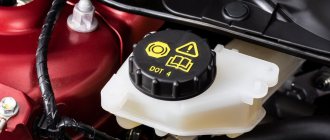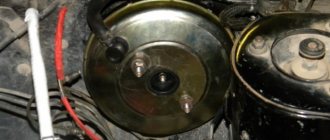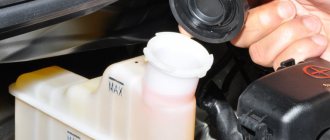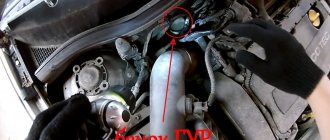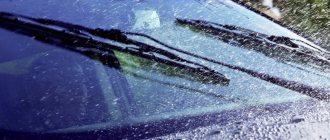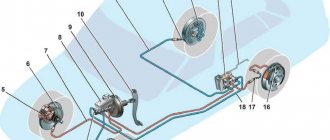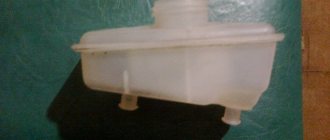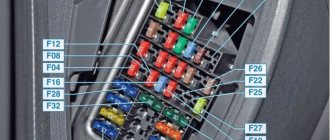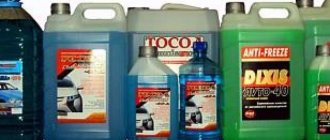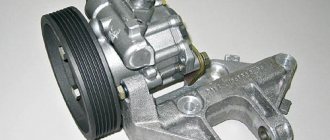Let's start with the fact that changing the brake fluid in a car is not difficult. The main thing is to have the desire and certain knowledge, because timely replacement of brake fluid, without exaggeration, can save your life.
Anyone can change a brake, but not every driver knows when to change it and why such deadlines are set, but it is advisable to know this.
If you have a domestic car, then it is necessary to change the brake fluid after 40 - 60 thousand km, depending on the make of the car, or after two years of operation of the car.
If it is a foreign car, then these indicators, as a rule, decrease; here you need to look in the instruction manual for the individual model.
Such timing for replacing brake fluid is due to the fact that the brake fluid experiences very heavy loads during operation of the vehicle’s braking system, as a result of which its temperature can rise to 150 degrees, and sometimes up to 200 degrees.
Of course, depending on the brand, any modern brake fluid, when it is still fresh, can withstand such loads and does not boil. But over time, its boiling point decreases, which impairs the performance of the braking system, and sometimes leads to its failure.
This happens because brake fluid is hygroscopic and constantly absorbs moisture, and water, as is known, has a lower boiling point, as a result of which, during braking, vapor locks form in the system, the pedal falls, and braking efficiency decreases.
Therefore, it is necessary to change the brake fluid regularly and without fail.
So, let's move on to the main question, how to change the brake fluid.
First of all, find out what kind of circuit diagram your car has, parallel or diagonal.
If parallel, then the procedure for replacing the TJ will be as follows:
- Right rear wheel;
- Left rear wheel;;
- Left front wheels;
- Right front wheel.
If the pattern is diagonal, then the sequence is slightly different. More on this later.
- Find out what brand of fluid is in your system. Although it is acceptable to mix a number of brands, it is still better if the brake fluid is replaced with the same brand that was filled.
- Buys TJ at least 1 liter.
- We prepare a transparent hose of the required diameter so that it is difficult to fit onto the air bleeder fitting.
- We prepare a key for 8 or 10, it’s not difficult to figure it out.
- We prepare a container where the old fuel fluid will be drained.
- Accordingly, rags and gloves.
- It is advisable to drive the car into a viewing hole or lift it with a lift.
- Don't forget about your partner. The work must be done by two people. By the way, you can bleed the brakes without an assistant.
Of course, you can change the brake fluid alone, but this is extremely inconvenient and takes a lot of time.
Description of brake fluid
Brake fluid is one of the important elements in the braking system of a car. It is she who transmits the force of pressing the brake pedal through the master cylinder to the calipers, which put pressure on the pads and stop the car.
Most liquids can be compressed, so it is impossible to transfer pressure from the pedal to the wheels using ordinary water. The chemical composition of the brake fluid allows pressure to be applied approximately in the same way as electricity is transmitted through wires.
The braking system must always be fully operational and cannot fail. Therefore, the liquid must meet the following parameters:
- Do not freeze in extreme cold.
- Maintain the chemical properties of the composition for a long time.
- Do not affect brake hoses, collars or other rubber parts.
- Have cleaning and lubricating properties that are necessary for the operation of the moving elements of the system.
- Have a high boiling point.
The main disadvantage of all brake fluids is their high hygroscopicity. Laboratory results show that the composition absorbs approximately 3% water from the air over a couple of years. This has a detrimental effect on the boiling point and significantly reduces the cooling resistance.
Boiling point is an important parameter. The fact is that during operation all components become very hot, including the liquid. When heated, small bubbles are released that prevent the transfer of pressure from the brake pedal to the wheels. If bubbles form, the brakes may fail completely and the pedal will simply be pressed all the way down. The operating temperature of a good liquid varies from -50 to +350 degrees Celsius.
Bleeding the brakes
For this you will need an assistant. The procedure for bleeding the brakes is the same as when draining or filling brake fluid. Ask your assistant to smoothly and fully press and release the gas pedal 4 times, then press it again and not release without your command. After the assistant has pressed the pedal for the fifth time, unscrew the bleeder valve and observe whether liquid comes out with bubbles or not.
To do this, it is convenient to lower the hose 1-2 cm into the brake fluid poured into a transparent container. If after 5-7 times no air bubbles appear, proceed to the next wheel. Do not forget to add brake fluid after bleeding each wheel. If during the process of changing the fluid or bleeding the brakes, fluid gets on the brake pads, roll the car out of the pit, overpass or lift and wash the pads with a stream of water.
How to determine whether the fluid needs to be changed?
If the brake pedal sinks significantly when driving along mountain serpentines or after prolonged braking, this is a sign of a large amount of moisture in the system.
A tight brake pedal when braking in winter can also be a clear indicator. For example, if while driving on a highway at -15 degrees the pedal becomes tighter than usual, then you should plan to change the fluid.
Toyota brake fluid has excellent lubricating and cleaning properties, so over time you can observe cloudiness of the composition in the reservoir under the hood. If you buy a used car and find a cloudy substance in the tank, it is better to immediately replace the composition.
There are also special devices for measuring water content. Such devices are inexpensive and in appearance resemble a ballpoint pen, only with built-in LEDs or even a display. To check, you need to dip the device's spout into the tank, wait for the signal and see the amount of water in the system. If the percentage of moisture content is more than 3-4, then the fluid must be replaced immediately. Toyota brake fluid accumulates a large amount of water in just a couple of years.
Why is replacement needed?
Tormazukha is a hydraulic solution, which over time may lose its original properties. Plus, it’s not uncommon for problems to arise with the braking system itself.
Varieties
The loss of the original quality and original characteristics of the brake fluid is caused by long-term operation under increased loads on the brake system.
This happens in the following way: when braking, the solution contracts, its viscosity is lost, and its consistency becomes more liquid. In addition, TJ is hygroscopic, that is, during the operational period it is saturated with moisture and water. As a result, the boiling point of the solution decreases and the liquid loses its properties.
Do not forget about mechanical damage and malfunctions that occur in the brake system. They also require a mandatory replacement of the hydraulic solution. Defects lead to leaks and air entering the system. Air locks are unacceptable because they cause the brakes to lose their effectiveness.
Replacement frequency
Many car owners are sure that the need to replace brake fluid is an advertising ploy by car services for the purpose of making money. After all, the system operates in a closed loop and does not communicate with air or moisture. This is a wrong position and a very dangerous delusion.
Replacing brake fluid on a Toyota is required every two years or every 20,000 kilometers, whichever comes first. In climates with high humidity, it is better to generally reduce the replacement time by half.
Timely replacement of the working composition will ensure full operation of the brake system and eliminate the appearance of rust and contamination inside the circuit.
What you need to know:
- Brake fluid should only be used as specified by the auto manufacturing company.
- When topping up, you need to use only new fluid and only that which matches the old one. Under no circumstances should you fill in a liquid that has already been used before, as it will contain various types of contaminants, impurities and oxides.
- When working with this liquid, you must behave very carefully and carefully, as it is very toxic. Never try to suck out brake fluid with your mouth. Store it only in a container, excluding general access to it. When working with it, you should always have clean rags on hand, since if it gets on the car body or other plastic parts, they may be damaged. If, however, chemical liquid gets on the above-mentioned parts, then in this case you need to rinse them with water and clean them with a rag.
- Do not allow brake fluid to come into contact with mineral oils. Even tiny traces of mineral oil can render brake fluid ineffective and lead to failure of the entire braking system. Gaskets and seals of the system can be damaged if they interact with products that contain mineral oils.
- Rags soaked in mineral oils are not used to clean system components. The liquid tends to absorb moisture from the environment and therefore should always be kept closed.
- The frequency of replacing brake fluid is once every 2-3 years, regardless of the mileage traveled. Or if the car has traveled approximately 50-60 thousand kilometers, then it should also be changed. It is recommended to replace the brake fluid after the cold season. The liquid is food that should not be thrown away or thrown away with everyday waste.
Which one to choose for Toyota?
Currently, manufacturers produce several types of brake fluid:
- DOT3;
- DOT4;
- DOT5;
- DOT5.1.
Compositions numbered 3, 4, and 5.1 are mixed with each other if topping up is necessary. Their chemical composition is supplemented with polyglycols; the packaging should indicate Hydratic.
Solutions containing silicone (DOT5) are designated Silicone base and are strictly not mixed with other liquids. It is also worth understanding that silicone content can cause damage to rubber products if they are designed for DOT4, DOT5.1 or DOT3. The difference between the compositions is fluidity, viscosity, freezing and boiling points.
So what kind of brake fluid should I fill in a Toyota? It's actually simple. The required composition is always indicated in the operating instructions or on the reservoir under the hood. Most often - DOT4. This applies to the choice of products from third-party manufacturers; if you purchase the original composition from Toyota, the necessary liquid will be inside the jar.
Test for compliance with the declared boiling point
I have already said that the effectiveness of the brakes depends on this temperature, or rather, the higher the boiling point, the better.
Our famous tiles will help you conduct such an experiment. Unfortunately, I only have two heat-resistant cups, so there will be some kind of competition.
Felix DOT-4 and Lukoil DOT-4
For the test, we will take liquids in approximately the same pricing policy: Felix DOT-4 and Lukoil DOT-4.
To make the process more fun, let's add thermal paste under the cups.
Please note that the first formation of bubbles began already at 190 degrees. But at a temperature of 200 degrees, both Felix and Lukoil boiled almost simultaneously.
Although Felix claims 250, and Lukoil – 230.
Lux and SINTEC
The next ones are Lux and SINTEC. Let's see how they perform. Active boiling of Lux brake fluid begins even before 200 degrees. He comes out of our experiment.
That leaves SINTEC. SINTEC began to boil at a temperature of 220 degrees. It’s not bad at all, but it’s still less than what’s stated on the label.
How can you trust the manufacturer after this?
Castrol and AWM
Our next tested oil is Castrol and AWM. The temperature is already more than 200 degrees, and the liquids still don’t even think of boiling. This makes me very happy.
I moved the thermometer and the AWM began to boil at 220 degrees. In principle, this is not bad, although for its price it is not very good.
Castrol boiled at 240 degrees.
Neva DOT-3 and Motul DOT 5.1
And the final test is Neva DOT-3 and Motul DOT 5.1. Let's see who wins. In theory, DOT-3 should boil at 180 degrees, and Dot 5.1 should boil at about 270.
The Neva began to boil, but not very actively at a temperature of 230 degrees. How is this even possible? Even Motul has already begun to boil slightly.
In this experiment, Neva will definitely be the leader.
Now let's move the thermometer to Motul and see what temperature it has. Motul also boiled, but at 240 degrees, that is, we have almost a leader somewhere on par with Castrol, only Motul 5.1, and Castrol DOT-4. Let's see how it performs in the next tests.
Now we will mix all our brake fluids, that is, pour them into one test tube in small quantities, including DOT 5.1, DOT-4 and DOT-3.
This experiment will clearly show us whether it is possible to add some kind of brake fluid or change it by substitution if we do not know what was filled in.
There are some distortions in the liquid. This suggests that they were not poured from the same barrel. Let's try to heat them up a little more and see what happens.
As you can see, there is no reaction, emulsion or sediment. This suggests that these brake fluid classifications are easily mixed.
Where to buy liquid?
You can purchase the original composition from Toyota from an official dealer. You should look for substitutes from the official representative of the brake fluid brand in your locality or contact well-known online stores. Purchasing from small stalls or garages can lead to replacement of brake system elements as a result of filling with counterfeit products.
When choosing a composition from a third-party manufacturer, it is better to give preference to:
- Bosch;
- TRW;
- Motul;
- Castrol;
- Ate;
- Liqui Moly.
All the manufacturers described above are responsible for the quality of their products and have proven themselves well in the market. Also on each package there is a protection by which you can identify a fake.
Performing the procedure alone
If necessary, you can change the brake fluid without involving an assistant. To create a slight excess pressure in the system, find a small car tire compressor connected to the cigarette lighter.
The compressor outlet hose must be tightly connected to the expansion tank in the following way:
- Buy an identical plastic brake reservoir cover and an air valve with a spool installed in the wheel rim from an auto store.
- Drill a hole in the center of the new (or old) cover and install an air valve there.
- Use a syringe to remove the old fluid from the expansion tank and add new fluid.
- Screw the upgraded plug onto the tank instead of the standard one and connect the air hose from the compressor to the nipple.
- Turn on the unit for literally 1 second so that it pumps up pressure no higher than 1 bar. After making sure that the lid and valve do not allow air to pass through, proceed to replacing the consumables.
In this case, the compressor will play the role of an assistant. Your task is to open/close the fittings of the working cylinders, pump up air in time and add brake fluid. Otherwise, the replacement technology does not differ from the pedal pumping technique. The main thing is not to exceed the pressure of 1 bar so that the plastic container does not crack.
At the end of the work, make a test drive and make sure that the car clearly responds to pressing the brake pedal . If dips occur, it means there is an air lock in the system. Air removal is carried out using the same method: an assistant creates pressure in the circuits by pumping, and you remove liquid through the valve until bubbles stop appearing (clearly visible in the transparent tube).
It is unacceptable to re-fill the fluid that has been removed along with air bubbles into the car’s brake system. Such material will quickly become saturated with moisture and become unsuitable for further use; in addition, it can provoke the formation of a new air lock.
Replacing brake fluid is not a simple process, with many nuances and subtleties. Having mastered them fully, you can easily repair your car in a short period of time.
Where is the tank located?
Toyota brake fluid has excellent cleaning properties and begins to darken as it wears out. You can visually see the condition of the composition in the expansion tank under the hood, which is located on the panel between the passenger compartment and the engine on the steering wheel side.
The reservoir, as a rule, has a bright yellow cap and is located on the brake master cylinder, which is a black round part screwed to the shield between the engine and the passenger compartment.
Check and control
To top up or evaluate the DOT4 status for effectiveness, you need to unscrew the reservoir cap. The cover is white or yellow, depending on the make and model of the car. It is worth paying attention to the fact that there are often instructions on the tank lid. When pouring DOT4, it is advisable to follow the instructions provided.
- It is important to know and remember that to top up brake fluid you must use the same substance that is already used in the reservoir and throughout the entire brake system. Information about the type of fluid can be indicated both in the car's manual and on the reservoir cap itself; as a rule, it is DOT4.
- DOT4 status is determined in two ways. An electronic tester that measures the boiling point of a liquid. Indicators within 165-175˚С are considered acceptable for further operation. In this case, at a reduced level, you can add the missing amount of the composition. And if the boiling point is less than 165˚C, the base has become unusable and it makes sense to completely replace the contents.
- In the absence of a tester, you can judge the structure of the brake fluid by its color. Fresh, high-quality liquid has a light yellowish color.
With prolonged use, DOT4 begins to darken, and the darker it is, the worse its quality factor, so to speak.
- Before opening the tank lid, it must be wiped with a lint-free, clean rag, so that no dirt or lint from the rag gets into the tank. You also need to make sure that the brake pedal is not pressed while the cap is being pulled off, since DOT4 may spray out of the reservoir and get on your skin. And this is very dangerous, since this substance is very toxic and caustic. It quickly dissolves paint, pipes, wires and has a detrimental effect on the skin. But if the substance does spill, it must be wiped off as soon as possible and the skin must be thoroughly washed with soap.
Once you open the lid, you can start topping up. To prevent the brake fluid from spilling during refilling, you can use a clean watering can.
- When adding DOT4, you need to simultaneously monitor the maximum and minimum level marks. If there are no marks, then the tank should be filled to 2/3 of its volume.
How to replace it yourself?
Self-replacement does not require special skills or special tools. In the place where the Toyota brake fluid reservoir is located, you need to put a rag so as not to accidentally spill new fluid on the engine hoses or plastic elements. You also need to buy a large syringe and a kit for the system in advance from the pharmacy. The silicone hose needs to be cut into several parts. The first one must be put on the nozzle of the syringe, and the second one must be secured to the unscrewed caliper fitting when bleeding the brakes.
To bleed the brakes, you need to remove the wheel to get to the fitting located on top of the caliper. You can look at the sequence in the manual or simply move from the far wheel from the master brake cylinder to the near one. For example, with a left-hand drive, the pumping order is as follows:
- Right rear caliper.
- Left rear caliper.
- Right front caliper.
- Left front caliper.
With a right-hand steering wheel:
- Rear left.
- Rear right.
- Front left.
- Front right.
To change the brake fluid you need to perform the following steps:
- Open the filler cap and carefully remove the strainer from the tank.
- Pump out the old fluid using a syringe and silicone hose from the pharmacy.
- Pour new composition up to the neck.
- Remove the wheel, put the hose on the caliper fitting and lower it into a transparent container.
- An assistant sitting in the car pumps the brake pedal several times and stops in the clamped position.
- While the pedal is pressed, you need to carefully unscrew the fitting, the liquid will begin to flow out through the hose into the container, and the brake pedal will sharply drop to the floor.
- Immediately tighten the fitting (an assistant must hold the brake pedal until the fitting is tightened).
- Repeat steps 5, 6, 7 until clean fluid flows from the caliper.
- Finish bleeding the remaining calipers.
During operation, you should pay attention to the presence of new fluid in the reservoir under the hood. Otherwise, air will enter the system, and the entire procedure will need to be started over again.
After completing the work, you need to make sure that the brake pedal is hard, there are no fluid leaks on the calipers, and the level in the reservoir is set to MAX.
Preparing to change brake fluid yourself
In some modern cars with complex “sophisticated” ABS, ESP and SBC systems, it is easier to replace the brake fluid at a specialized car service center. This will take a little time (about 30 minutes), the system will not be air-filled, and the price is within 1000 rubles. not so scary.
For those who like to save money, and also in the absence of trust in the service station employees, you will have to change the brake fluid yourself. To work you will need several tools, devices and materials:
- a soft transparent tube, the inner diameter of which corresponds to the outer diameter of the bleeder fitting on the wheel cylinder;
- an open-end or socket wrench for unscrewing the “bleeder”;
- container for collecting used brake fluid;
- new fluid;
- reliable assistant.
It is better to carry out the work in a viewing hole or on an overpass. If you can get to the bleeder fittings from below with a wrench and a tube, then it is not necessary to remove the wheels. Otherwise, you will need a jack and a wheel wrench, and you will also have to spend extra time dismantling and installing the wheels.
One person goes under the car with a wrench, hose and container. The second one sits comfortably behind the wheel of a car. There must be constant voice communication between partners.
The operating sequence depends on the type of brake system of the vehicle.
- With a diagonal circuit pattern, the rear right wheel is pumped first, then the front left, rear left and finally the front right.
- To bleed a parallel system, you need to start from the right rear wheel, moving sequentially to the left rear, right front and left front wheels.
How much does it cost to replace it in a workshop?
Few car owners know how to replace Toyota brake fluid. And when they see the instructions, they completely refuse to carry out the work themselves.
In fact, the replacement procedure is very simple and only takes about an hour. The cost of one liter of brake fluid starts from 400 rubles. Toyota brake fluid will cost from 1,500 rubles.
In case of replacement at the station, you will have to pay additionally for the work. At an official dealer, such a procedure can cost from 4,000 rubles + materials, but at a car service center they will ask for from 1,500 rubles + materials. In case of self-replacement, you will only need a canister with new liquid, a syringe and hoses from the system from the pharmacy.
Tools required to remove the reservoir
To remove the reservoir on a car, you need the tools from the table below.
Table - Tools for removing the brake fluid reservoir
| Name | Note |
| Syringe | Can be replaced with a rubber bulb |
| Hose | Length 20-50 cm |
| Tara | To drain the brake fluid |
| Screwdriver | With flat and cross blade |
| Wrench | May be required in rare cases. Its size depends on how the tank is mounted on a specific car model. |

